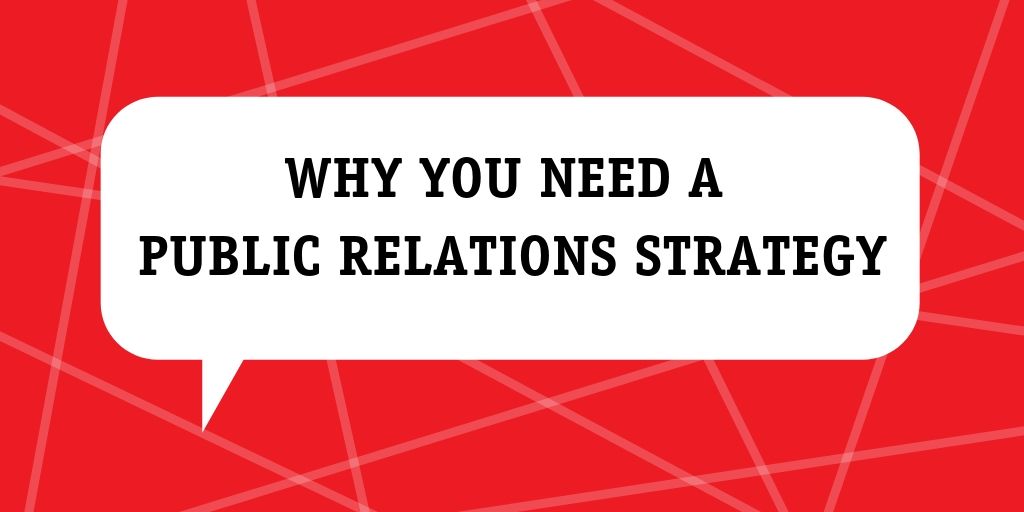
11 Jul Why you need a public relations strategy
Read time: 5 minutes
Everyone’s heard of ‘public relations’ but what does PR actually involve? And why do you need a public relations strategy?
Public relations, by definition, is the state of the relationship between a company and its publics (publics meaning anyone involved with or affected by the company). A public relations strategy looks at what you can do to improve the relationship between your company and its employees, customers, suppliers, business partners, the community and so on.
Public relations efforts are almost always unpaid forms of communication/publicity. If you are paying for ad space or a feature article in a magazine, you are advertising, not creating publicity. Unpaid publicity is beneficial as consumers see it as a more reliable source of information. Consumers are more likely to perceive information they are seeing ‘organically’ as more trustworthy.
Why you need a public relations strategy
Not sure why you need a public relations strategy? A public relations strategy is useful if you need to get a key message out to your publics. This is particularly useful for medium to large size businesses who need to communicate to large audiences. If you need to communicate a message to an audience, build stronger relationships with your publics, create a buzz around your brand or improve your brand’s reputation, a public relations strategy will help you.
A public relations strategy will:
- Focus on a key message
- Address your communications goals
- Identify your target audience
- Define which PR tools will best communicate your message
- Analyse risks and put in place processes to best mange those risks
- Consider your brand reputation and how to improve it
A public relations strategy can be created for a range of different reasons. Each strategy will involve a combination of different tactics to work towards communicating a key message.
What does a public relations strategy actually involve?
Public relations is many things. It involves many different strategies and tactics that work together to achieve communication focused goals.
The different components of public relations:
- Publicity
Publicity refers to a company’s presence in the media (without paying for it). Publicity can be created through running an event, raising money for a charity, launching a new and unique product or by winning an important award and notifying news sources. Whatever it is, it needs to be newsworthy.
- Crisis management
There is a risk of crisis in every company. No matter what industry you’re in, you should have a plan in place for managing a crisis. A crisis management plan is an important tool that can be used for recognising risks, minimising risk, and managing a crisis if it occurs. A poorly handled crisis can result in permanent damage to a company’s reputation.
- Event coordination
Events are a great way to create buzz around a brand. They’re also a great tool to connect with your publics and build stronger relationships. Events also often act as a talking point for publicity around a brand.
- Media kits
Media kits are a pre-prepared set of promotional materials that provide information about your company that the media/journalists can use to learn more about the company when preparing stories.
- Press releases
Press releases are sent out to the media when attempting to gain publicity. They contain all the information about your event, charity donation, new product etc. in a clear and concise way so that journalists can quickly read it and pull out any information that they believe to be newsworthy.
- Social media
Social media, like many digital marketing tools, is often used as public relations tool. Using social media gives businesses a way to connect with consumers. Social media, as a PR tool, is all about strengthening the relationships between the company and consumer by posting meaningful content and actively responding to customers. Having a presence on social media makes your company more accessible to customers and your company is more likely to be perceived as being trustworthy.
- Media monitoring
Media monitoring is necessary if your company is often discussed or involved in the media. Your company should be ready to address any negative media representation, and to find any positive media discussions so that it can be promoted across other channels.
- Reputation management
Your company’s reputation is paramount. If you don’t have a good reputation, you won’t have a good relationship with your publics and your business won’t be sustainable. Reputation management looks at your public’s current perception of the company and how to improve it.
- Influencer campaigns
Social media influencers are the newest form of media publishers. They create content and present it to their large follower base. Because they are not a traditional media source, consumers see them as more trustworthy and reliable. There are two forms of influencer campaigns; paid influencer sponsorships and press. Sending an influencer some of your products for free can be a great way to get them trying your products and talking about your brand online without paying them anything, also known as a ‘collaboration’.
The many different components of public relations are considered when designing a public relations strategy to make sure that all media channels have a consistent message. Consistency is key in a good PR strategy.
Do you need help with public relations? Redsteps can help. Contact us today and tell us about your communication needs! Email hello@redsteps.com.au
Be the first to know about our latest blog posts! Follow us on Facebook today.
